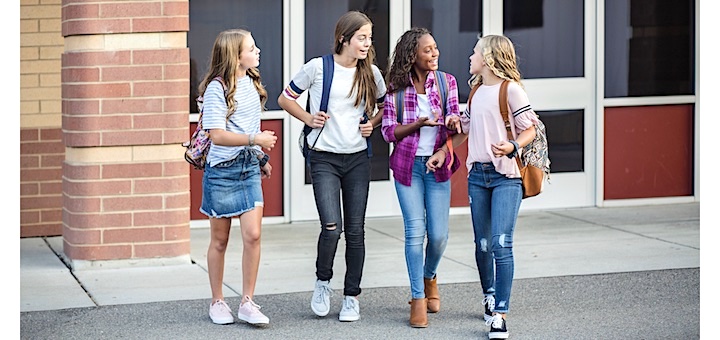1 Sure Way to Make Your Students Instantly Smile
A MiddleWeb Blog

But I digress. Here’s my one-tip listicle.
The Social Studies teacher across the hall and I have a near-daily fashion conversation going on. We both love lewks and experimenting with color and texture, so we get and give daily affirmations for colorful shirts, banging boots, and finally figuring out how to style white pants in January. (There are no rules.) It’s unacademic and meaningless, and occasionally one of the nicest parts of my day.
We do this because we both hang out in the doorways of our rooms for the four minutes between classes, greeting kids as they come in, inserting snarky comments into overheard conversations as students whizz by (“I ALSO think you should go to the dance, Richard…”), and, of course, complimenting kids on what they’ve got on or with them.
This is especially fun after the holidays or birthdays, when a certain shininess to shoes or sweaters may indicate that they’re presents they’ve brought to school to show off.
Lots of things fail in public school: Initiatives. Curricula. Adequate funding. (Sorry, I had to.) But after twenty plus years of teaching, one thing almost never fails: the positive reaction you get when you genuinely compliment a kid on their appearance.
Lewking good
Tween and teen kids care deeply about their appearances, particularly now in their developmental stage, when how they fit or don’t fit into their peer communities is a critical occupation of their minds. They have almost certainly put a great deal of thought into their appearance at school, even if it doesn’t fit in with our adult preconceived notions of what is “nice” (or even the dress code, frankly).
So whether it’s box braids, artfully ripped jeans, or even just a beaded safety pin carefully placed on a backpack, when you show you’ve noticed in a positive way, it can be the first time a student feels genuinely connected to you – because you’re speaking their language, not imposing your own.
Four guidelines for implementing this strategy
1. An eagle eye for their beauty. I myself would not choose to wear six loops of interconnected pop can tabs as a bracelet, but Ariel spent days connecting them using pliers. Tell them it’s cool. Ask them how they did it. Find something beautiful or clearly meaningful to the kid, from every socioeconomic stratum, every color and gender. It’s always there.
2. Be genuinely curious. “How long did that take you?” is a great question to ask a kid about a new hair stripe, nail polish, or the intricate pen doodles on their hands from study hall. They’re typically ready to moan over the hours it took or be smug about the efficient five minutes. Celebrate their perseverance or their cleverness, either way.
3. Less is more. “Gorgeous earrings.” “That sweatshirt looks so cozy.” “Those aren’t new sneakers? You’ve taken such good care of them!” This kind of quick compliment works very well when you’re just passing a student (or they’re just passing you). There are no awkward responses or continuations for either them or you, and they don’t have time to get embarrassed. (Footwear is almost fail safe, since it tends to be such a status symbol among kids.)
4. Honesty is everything. Don’t fake your interest or your approbation – kids can sniff that out a mile away.
Which can leave us with the question: “But what if I can’t find anything beautiful or interesting about a certain kid?” What I would tell you then, with great compassion and kindness, is that there is always something beautiful or interesting about a kid.
We’ve all got days where it’s hard to find the good in anyone – so you may want to reserve this technique for when you’re not grumpy or sick. But if you’re a teacher who can’t find beauty regularly in your students, I might gently suggest that’s what the kids call “a you problem.”
































Always love your insightful, “snarky,” wonderful observations and ideas! You are a gift to students and those of us who work with them! Keep posting, Diana! You always make me laugh and think, “Oh, so true!”